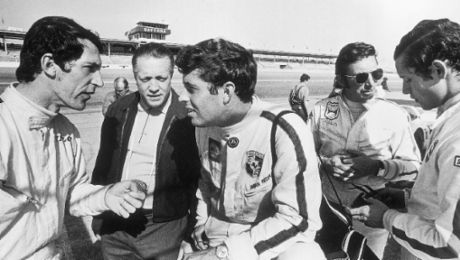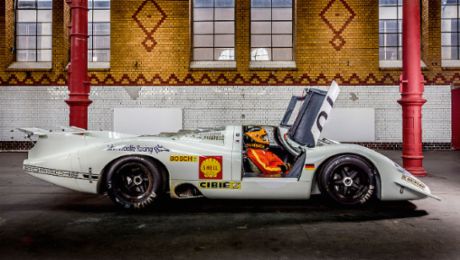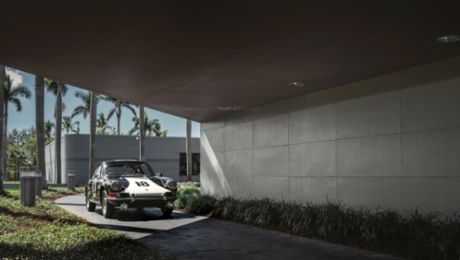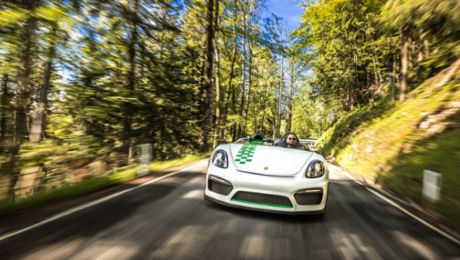The sun is shining in Le Mans, persistently and intensely. Its location on the western periphery of the Central European time zone ensures it enjoys long evenings. It feels like your life could be extended here. And it is, actually. Because the Classic version of the 24 hours of Le Mans always seems “younger” than the modern one, which usually takes place three weeks before. The Le Mans Classic still has a youthful innocence, a wildness, not yet as tame as the main race. It’s a start-up, not a major corporation. It’s a revival of the spirit of the world’s most famous and dangerous car race. This is the place where the most exciting racing cars of the past few decades will be travelling at race speeds.
And Arndt Ellinghorst will be driving one of them. He’s used to driving, but in a different context. He’s actually an automotive analyst. This German gentleman works for Evercore International Strategy & Investment Group in London, an American investment banking consultancy, where he’s Head of Global Automotive Research. The boss. 46-year-old Arndt provides investment recommendations based on indicators such as price-earnings ratios, cash flow or liquidation values. His team of 25 highly qualified staff assist him with this. Arndt’s knowledge is in demand. He appears on the world’s most well-known business channels on TV, he’s quoted in famous newspapers in Germany, the UK and the USA. What he says affects people – and sometimes millions of dollars, euros or pounds.
But this weekend he’s enjoying some time off. Time for what he likes to spend his time thinking about during the week – cars. And time for a car that’s perhaps the purest, most perfect of its kind, for generations: the Porsche 911. And on a racetrack that’s more temptation than tarmac – Hunaudières, Tertre Rouge, Mulsanne, Arnage. These sections of the circuit, covering 13.6 kilometres, convey those crucial moments of people in motion – desire, seduction, pleasure, perfection. Le Mans promises all this. But words like doom or fate can also be found in the small print of this pact between driver and track. But Le Mans is all about devotion, and there’s no point dwelling on the small print when it comes to devotion. You just think big. Like Arndt Ellinghorst always does. As a man with drive and passion, it’s not just the race as such that captivates him. His partner for the night does, too – a high-speed car with a history that reads like a film script.
It all began on July 19, 1967. A Wednesday that was so hot that police officers were allowed to perform their traffic duties without wearing ties or collars. On this day, Karl Schweizer from Waiblingen collected his Porsche 911 T/R. But his joy was short-lived, because the car was destroyed in an accident that same year. The car was then re-shelled and sold to driving school owner Philippe Farjon in Paris. He converted the 911 into a racing car to compete in the 24 Hours of Le Mans in 1969, together with his friend Jacques Dechaumel.
Their unorthodox road to Le Mans caused something of a stir. A camera team accompanied them and shot a documentary about the car – number 67 in the race, registration 18 VQ 75. The programme listened in on the two men as they chatted, heard them going on about rpm, improving lap times, how to fine-tune their strategy. They ate steak, but most of it was left on their plates. But no, the fear wasn’t what blunted their appetites. You could feel the uncertainty in the pits when an accident at Maison Blanche was reported over the tannoy – but their car wasn’t involved.
They ended up coming 14th, and their Porsche completed 3,845 kilometres. Average: 160 km/h. This Porsche competed here in 1970 and 1971 as well, in the fastest race of the century, before losing its way for decades – until that hot day in 2018, when the number 67 Porsche reappears in the pits, looking splendid and bearing its old registration number. Michael Roock of Roock Sportsystem restored it for Arndt Ellinghorst. “I wanted this car to return to France, to Le Mans. As a tribute to those two guys, too, who once prepped the Porsche for the race. I didn’t know the story before, but you can see this Porsche has touched the hearts of a lot of people and that it means something to many of them to see the car here again. Just the way it was, right down to the tiniest sticker, the number on the side, everything,” is how Ellinghorst describes what this unusual race project was aiming to achieve.
“It’s just wonderful to drive.” Arndt Ellinghorst
The car’s past, which is still fascinating today. The car’s technology – very much of its time – which is still fascinating today. The timeless 911 time machine: Ellinghorst adores the beauty of numbers and mechanical systems. “Of course, the Porsche has a racing suspension, the car weighs 940 kilograms, the gearshift is incredibly good, the gearing was relatively long for Le Mans, but it worked beautifully.” Facts in his head. Too many. There’s a pause, a sigh, then: “It’s just wonderful to drive.” Full stop.
Despite his career choice, Arndt wasn’t a petrolhead in the classic sense in his formative years. His family didn’t have a TV to watch on Sundays, so there was no Formula 1 for him. “But the myth of Le Mans has already told me something. Steve McQueen, the film, all the things people say about that story.” And so he sums up his youth. But today, he knows. “It’s the race to end all races.” And ever since he and his brother got involved in restoring cars, one thing has always been clear to him – if he were ever to drive the Le Mans Classic, it’d be in a Porsche. “I’m fascinated by the old cars, the history of the enterprise – and, to an extent, the stubbornness with which people pursue and achieve their goals, all the things others said they wouldn’t be able to do. This willingness to go to their limits, work really hard, challenge themselves and the equipment to extremes. That’s exactly why races like this have become the brand essence of Porsche.” The history of Porsche and Le Mans is fascinating. And this yesterday suddenly comes to life again in the pit lane of today. Elegantly dressed ladies stand on the wall and measure lap times with a stopwatch. Okay, on their iPhones nowadays, but just the fact that the lap times are written down on paper afterwards is like a trip into years gone by.
Famous professional racing driver Claudia Hürtgen is part of the team
But while Arndt is happy to be sentimental, he wants to be fast as well. So that’s why he’s included Claudia Hürtgen, one of Germany’s most famous professional racing drivers, in his team. She’s driven in the main race here four times, and one of her first mentors was Dr. Helmut Marko, who set the distance record here back in 1971 – the year in which the number 67 Porsche lapped the course for the last time. Arndt listens carefully to Claudia Hürtgen. This might be unusual for someone who’s used to thinking aloud, inspiring others and showing them the way; but this is what he does, and you can see the respect he has for these 38 corners over a distance of 13.629 kilometres. He listens to Claudia Hürtgen – and to the track itself, which has a sound like no other. Especially at night, when the folk festival next door gets louder and louder. There’s also the smell of barbecuing, when the fans eat and drink together in the woods. And he listens to the number 67. It doesn’t just seem like it was made for Le Mans – it WAS made for Le Mans. Half a century ago, by two men who stubbornly pursued and achieved their goal.
It’s Sunday, late morning. Everybody’s tired and lethargic because of the incredible heat of the day. Suddenly, a man in the pits comes over to Arndt and tells him he’s Jacques Dechaumel’s nephew. And then there’s no stopping him: what it means for him to see the car again, fast and beautiful just as it always was. This moment will last forever. A story as unexpected, as unbelievable as the story of this Porsche itself. A story that only Le Mans can write. The fact that the number 67 Porsche ends up winning two of the three races in its class is a matter of honour. And incidental.
Info
Text first published in the magazine "Porsche Klassik", issue 15.
Text by Gerald Enzinger // Photos by Vince Perraud
Copyright: The image and sound published here is copyright by Dr. Ing. h.c. F. Porsche AG, Germany or other individuals. It is not to be reproduced wholly or in part without prior written permission of Dr. Ing. h.c. F. Porsche AG. Please contact newsroom@porsche.com for further information.



